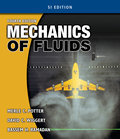
MECHANICS OF FLUIDS presents fluid mechanics in a manner that helps students gain both an understanding of, and an ability to analyze the important phenomena encountered by practicing engineers. The authors succeed in this through the use of several pedagogical tools that help students visualize the many difficult-to-understand phenomena of fluid mechanics. Explanations are based on basic physical concepts as well as mathematics which are accessible to undergraduate engineering students. This fourth edition includes a Multimedia Fluid Mechanics DVD-ROM which harnesses the interactivity of multimedia to improve the teaching and learning of fluid mechanics by illustrating fundamental phenomena and conveying fascinating fluid flows. INDICE: 1. BASIC CONSIDERATIONS. Introduction. Dimensions, Units, and Physical Quantities. Continuum View of Gases and Liquids. Pressure and TemperatureScales. Fluid Properties. Conservation Laws. Thermodynamic Properties and Relationships. Summary. Problems. 2. FLUID STATICS. Introduction. Pressure at a Point. Pressure Variation. Fluids at Rest. Linearly Accelerating Containers. Rotating Containers. Summary. Problems. 3. INTRODUCTION TO FLUIDS IN MOTION. Introduction. Description of Fluid Motion. Classification of Fluid Flows. The Bernoulli Equation. Summary. Problems. 4. THE INTEGRAL FORMS OF THE FUNDAMENTAL LAWS. Introduction. The Three Basic Laws. System-to-Control-Volume Transformation. Conservation of Mass. Energy Equation. Momentum Equation. Moment-of-Momentum Equation. Summary. Problems. 5. THE DIFFERENTIAL FORMS OF THE FUNDAMENTAL LAWS. Introduction Differential Continuity Equation. Differential Momentum Equation. Differential Energy Equation. Summary. Problems. 6. DIMENSIONAL ANALYSISAND SIMILITUDE. Introduction. Dimensional Analysis. Similitude. Normalized Differential Equations. Summary. Problems. 7. INTERNAL FLOWS. Introduction. Entrance Flow and Developed Flow. Laminar Flow in a Pipe. Laminar Flow between Parallel Plates. Laminar Flow between Rotating Cylinders. Turbulent Flow in a Pipe. Uniform Turbulent Flow in Open Channels. Summary. Problems. 8. EXTERNAL FLOWS. Introduction. Separation. Flow Around Immersed Bodies. Lift and Drag on Airfoils. Potential Flow Theory. Boundary Layer Theory. Summary. Problems. 9. COMPRESSIBLE FLOW. Introduction. Speed of Sound and the Mach Number. Isentropic Nozzle Flow. Normal Shock Wave. Shock Waves in Converging-Diverging Nozzles. Vapor Flow through a Nozzle. Oblique Shock Wave. Isentropic Expansion Waves. Summary. Problems. 10. FLOW IN OPEN CHANNELS. Introduction. Open-Channel Flows. Uniform Flow. Energy Concepts in Open-Channel Flow. Momentum Concepts in Open-Channel Flow. Nonuniform, Gradually Varied Flow. Numerical Analysis of Water Surface Profiles. Summary. Problems. 11. FLOWS IN PIPING SYSTEMS. Introduction.Losses in Piping Systems. Simple Pipe Systems. Analysis of Pipe Networks. Unsteady Flow in Pipelines. Summary. Problems. 12. TURBOMACHINERY. Introduction. Turbopumps. Dimensional Analysis and Similitude for Turbomachinery. Use of Turbopumps in Piping Systems. Turbines. Summary. Problems. 13. MEASUREMENTS IN FLUID MECHANICS. Introduction. Measurement of Local Flow Parameters. Flow Rate Measurement. Flow Variation. Data Acquisition and Analysis. Summary. Problems. 14. COMPUTATIONAL FLUID DYNAMICS. Introduction. Examples of Finite Difference Methods. Stability, Convergence, and Errors. Solution of Couette Flow. Solution of Two-Dimensional Steady-State Potential Flow. Summary. APPENDIX A. UNITS AND CONVERSIONS AND VECTOR RELATIONSHIPS APPENDIX B. FLUID PROPERTIES APPENDIX C. PROPERTIES OF AREAS AND VOLUMES APPENDIX D. COMPRESSIBLE-FLOW TABLES FOR AIR APPENDIX E. NUMERICAL SOLUTIONS FOR CHAPTER 10 APPENDIX F. NUMERICAL SOLUTIONS FOR CHAPTER 11
- ISBN: 978-1-4390-6203-6
- Editorial: Nelson Engineering
- Encuadernacion: Rústica
- Páginas: 880
- Fecha Publicación: 11/04/2011
- Nº Volúmenes: 1
- Idioma: Inglés
